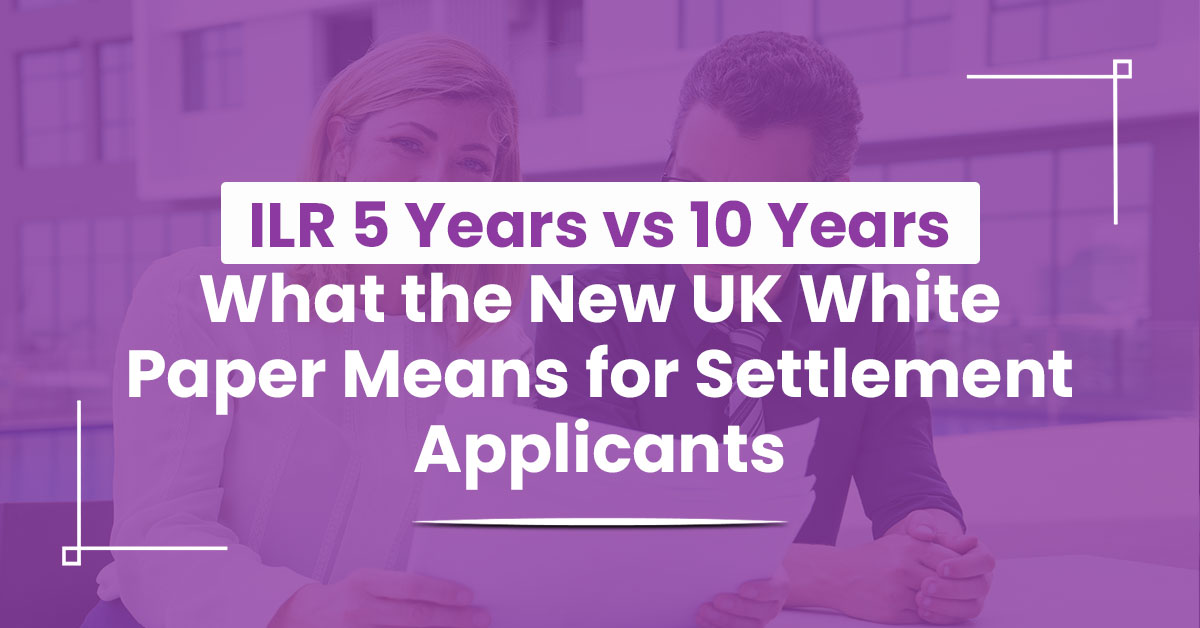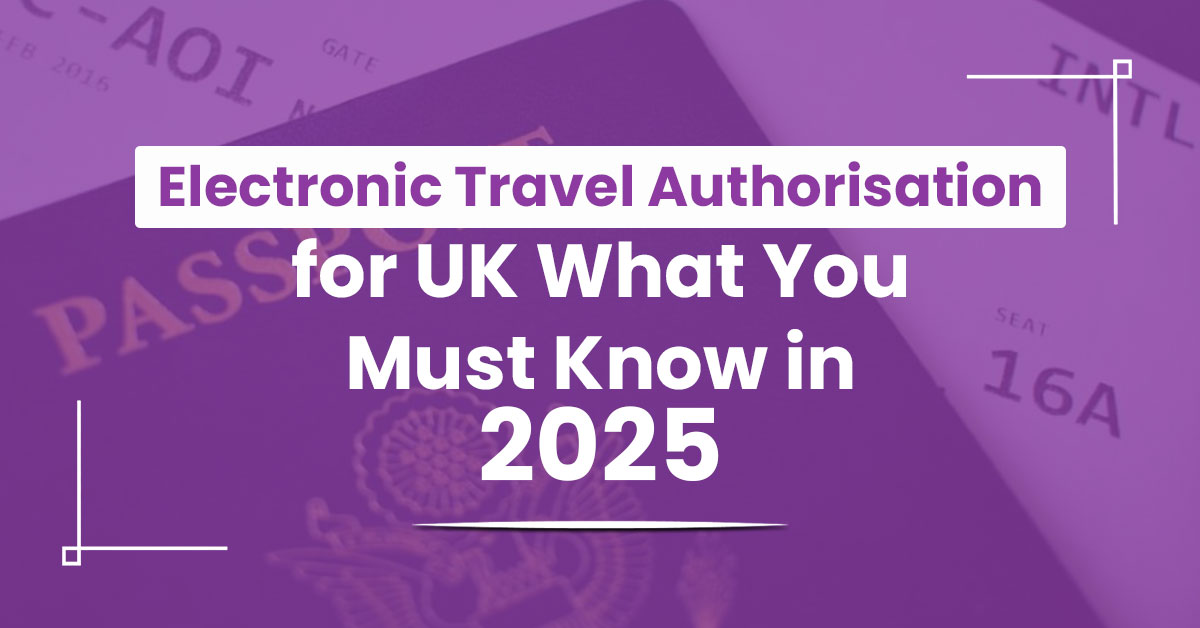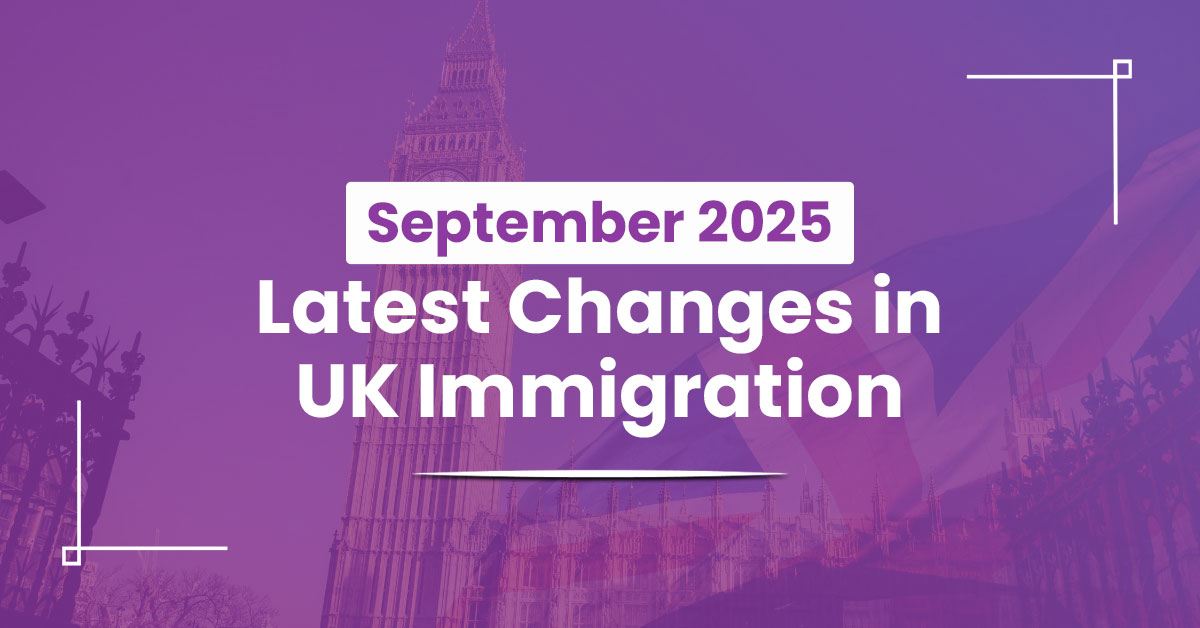The government has announced plans to make it more difficult to gain permanent residency in the UK, often known as settlement or Indefinite Leave to Remain (ILR), in the Immigration White Paper that was released on 12 May 2025.
Currently, migrants are normally eligible for settlement after five years in the UK on a valid visa. Although it is unclear who will be impacted, this normal time will double to ten years under the new rules for some migrants. In this blog, we will discuss the possible effects of the policy on applicants.
Key Takeaways
- The 2025 UK Immigration White Paper proposes doubling the standard settlement period from 5 years to 10 years for many migrants.
- The change aims to introduce an “Earned Settlement” system, where those showing strong economic or social contributions may qualify earlier.
- Indefinite Leave to Remain (ILR) allows individuals to live, work, and study permanently in the UK without further visa renewals.
- Most Points-Based System (PBS) migrants, including Skilled Worker and Health & Care Worker visa holders, could face a 10-year qualifying period.
- Family visa routes are expected to retain the 5-year ILR timeline, recognising their distinct humanitarian and family objectives.
- English language requirements for ILR are set to increase from level B1 to B2.
- Migrants’ costs will rise sharply, e.g., Skilled Workers could pay £16,900 over 10 years, compared to £9,900 currently.
- The new system would generate higher revenue for the Home Office but could slow integration and delay access to citizenship.
- Family unity and fairness concerns are key criticisms, especially for those who plan around 5-year expectations.
- The policy is under consultation and expected to take effect in 2026, following parliamentary approval.
- Current ILR holders will remain unaffected; transitional rules are expected for those already on 5-year paths.
- The EU Settlement Scheme and Global Talent visa holders are likely to keep or gain preferential routes.
What is Indefinite Leave to Remain (ILR)?
An immigrant who obtains indefinite leave to remain (ILR) can permanently reside in the UK without being subject to any immigration limitations. ILR is also referred to as “settlement”, “settlement visa”, or “permanent residence“.
With ILR, you and your family can permanently reside in the UK, enjoying all the benefits of living, working, and studying there without ever having to apply for another visa. Indefinite Leave to Remain is the final stage towards obtaining British citizenship. It is the ultimate goal for many people who travel to the UK to live, work, or be with family.
ILR 5-Year vs ILR 10 Year Route
Unsure which ILR route applies to you? Here’s a quick breakdown of the ILR 5 years or 10 years UK 2025.
| Topic | 5-Year ILR (current standard for many routes) | 10-Year ILR (10-year long-residence & proposed default) |
| Qualifying period | Typically 5 years on qualifying routes (eg, skilled worker, partner routes where rules allow). | 10 years is the established long-residence route (must have 10 years of continuous lawful residence). The 2025 White Paper proposes making 10 years the default qualifying period for many Points-Based System migrants (with possible faster “earned” pathways for contributors). |
| Who it applies to | Persons on specific settlement-leading visas that explicitly allow settlement after 5 years (eg, certain Skilled Worker, Partner, Ancestry, and some family routes). | The 10-year long-residence route is available to people who have accumulated 10 continuous years in the UK across visa types. The White Paper’s change would make 10 years the default for many PBS migrants (affecting future entrants unless an earned shorter route applies). |
| Continuous lawful residence / permitted absences | Varies by route; Home Office rules normally limit absences (e.g., usually ≤180 days in any 12 months for many settlement applications). Check route-specific guidance. | For a 10-year long residence, the rules require continuous lawful residence (very limited permitted absences and strict counting rules). The White Paper would use 10 years as the benchmark for default settlement, with details subject to implementation/consultation. |
| English language & ‘Life in the UK’ test | Most 5-year settlement routes require meeting the English requirement and passing the Life in the UK test (route-specific exceptions exist). | The White Paper signals stricter standards overall (higher English / contribution checks likely for many categories). The exact requirements for a new default 10-year path will be set in rules/consultation. Existing 10-year long-residence applicants already must meet English/Life in the UK requirements when applying for ILR in many cases. |
| ‘Contribution’ or points-style tests | Historically, not been an explicit universal “contribution” points test for 5-year ILR (conditional on route eligibility, employment, salary thresholds, etc.). | White Paper proposes an “earned settlement” approach, people who can demonstrate positive economic/social contributions may qualify earlier than 10 years (or under a shortened pathway). This is a central policy change. |
| Family/asylum implications | Family & partner routes currently have specific 5-year settlement pathways; asylum/refugee settlement rules have historically allowed settlement after 5 years in many cases (with family reunion provisions). | White Paper proposals include tightening refugee/family reunion rights and moving many categories to a longer baseline settlement period (10 years), with critics warning of impacts on family reunification and fairness. |
| Transitional / grandfathering | If rules change, Government statements indicate some groups already settled under prior rules may be protected, but details are politically contested and depend on legislation/implementation. | The White Paper proposes exemptions / earned routes for some categories (and suggests those already in certain cohorts may be handled separately), but many commentators warn retrospective changes would be unfair and legally complex. Expect formal consultation and phased measures. |
| Strengths (pros) | Faster route to settlement encourages integration, family stability, and workforce planning. Predictable for migrants who planned on a 5-year route. | A longer default period may reduce settlement rates, align with tighter immigration control objectives, and allow the Government to prioritise “high-contribution” migrants for faster settlement (via earned routes). |
| Risks/criticisms (cons) | Seen by proponents as fair and predictable, critics say some routes didn’t ensure sufficient contribution checks. | Critics argue that moving the default to 10 years would be unfair to people who made life decisions under a 5-year expectation (housing, jobs, schools), and could harm family unity and integration; legal/administrative complexity is also a concern. |
Pro Tip:
Review your visa/route history for gaps or risky switches. Time spent under visa types that don’t normally lead to settlement (e.g., student visas) may still count under the 10-year “long residence” route, but gaps or periods of being undocumented may complicate eligibility.
What does the UK White Paper Propose for Settlement Applicants?
Several major changes to the UK settlement (ILR) are proposed in the UK Government’s 2025 Immigration White Paper. These modifications, however, are merely suggestions and must be approved by a Statement of Changes to the Immigration Rules.
- Based on the Points-Based System (PBS), a new method for ILR called “Earned Settlement” will be implemented.
- For the majority of immigration categories, the typical qualifying period for permanent resident status will be raised from five to ten years.
- Across most immigration routes, the English language requirement for ILR will be increased from level B1 to B2.
- Anyone who has lost a child while on a visa as a parent of a British or settled child can now apply for immediate settlement through a new bereaved parent route.
- Undocumented children and care leavers who have lived in the UK for a long time will be eligible for regularisation and settlement pathways.
Note: Dependants of British nationals, including those on a Spouse Visa, will still be able to get ILR after five years as long as they meet all other requirements.
You can find out more about the recent UK immigration changes here.
Proposed Timeline Adjustments by Visa Category
The upcoming ILR 10-year policy is expected to reshape settlement timelines across different visa routes. Work-based categories such as Skilled Worker and Health and Care Worker visas may see the longest extensions, while some protected groups could retain their existing 5-year paths or gain revised settlement privileges.
| Visa Type | Now | Proposed | Who’s Affected |
| Skilled Worker | 5 years | 10 years | 300k+ professionals |
| Health & Care | 5 years | 10 years | 150k+ healthcare staff |
| Family | 5 years | 5 years (kept the same) | Likely exempt |
| Hong Kong BNO | 5 years | Under review | 108k+ petitioners |
| Global Talent | 3–5 years | Upgraded path | May get priority |
Do You Know?
The White Paper doesn’t conclusively state whether people already on 5-year ILR trajectories will be forced to abide by the 10-year rule, which is subject to consultation.
How These Changes Could Affect Applicants
A 10-year settlement route would make the UK more restrictive than most high-income nations, similar to Switzerland and Japan.
The overall impact on migration levels is expected to be small, as settlement timelines don’t strongly influence migration decisions.
- Migrants will face higher costs due to longer visa durations and repeated extensions.
- Example: A single Skilled Worker currently pays ~£9,900 for 5 years; under the new system, costs could rise to ~£16,900 over 10 years.
- The increase is mainly from paying the Immigration Health Surcharge twice as long.
- These changes would generate more revenue for the Home Office but raise financial pressure on migrants, especially lower-income families.
- Longer routes delay access to permanent rights and citizenship, limiting migrants’ job mobility and bargaining power.
- Studies show secure or permanent status improves:
- Employment outcomes and job stability
- Language learning and community integration
- Economic and social inclusion
- Therefore, the 10-year ILR route creates a trade-off: higher income for the government versus slower integration and reduced well-being for migrants.
If you need assistance with ILR applications, you can call our immigration experts at 02033844389.
Frequently Asked Questions (FAQs)
Q1: Is UK ILR changing to 10 years?
Ans. No, the UK government is examining all Indefinite Leave to Remain (ILR) options; however, some routes, such as those on student visas or through extended residency, may be affected by or already have a 10-year qualifying limit.
Q2: What happens to my ILR if rules change?
Ans. New regulations may affect your capacity to become a British citizen, but if you already have Indefinite Leave to Remain (ILR), it is usually secure from changes that effect previous applications.
Q3: When will the UK 10-year indefinite leave to remain changes take effect?
Ans. After the Westminster Hall discussion in September 2025 and the subsequent consultation in late 2025, the new policy is expected to take effect in 2026. The schedule provides for parliamentary review, public consultation, and legislative approval. People who already have a visa and are close to qualifying for a 5-year visa can apply under the current standards before the changes take effect, as long as they follow certain transition rules.
Q4: How might the 10-year rule effect British citizenship applications?
Ans. Under normal progression, the overall qualifying time could range from 6 years to 11+ years, since citizenship usually takes 12 months of indefinite leave.
However, exceptional contributors may be able to take advantage of expedited pathways under the proposed “earned citizenship” framework. The amendments have a significant impact on long-term UK residence and naturalisation plans for work visa holders.
Q5: Which visa types are most likely to maintain 5-year settlement timelines?
Ans. Family-related visas are expected to maintain the 5-year route to settlement, as the government acknowledges the unique objectives of family migration. Applicants under the EU Settlement Scheme will continue to benefit from the protections granted by the Withdrawal Agreement.
Meanwhile, Global Talent and other high-achiever categories may receive preferential settlement options. The Hong Kong BNO visa timeline is still under review, with strong public calls to preserve the current 5-year pathway.






